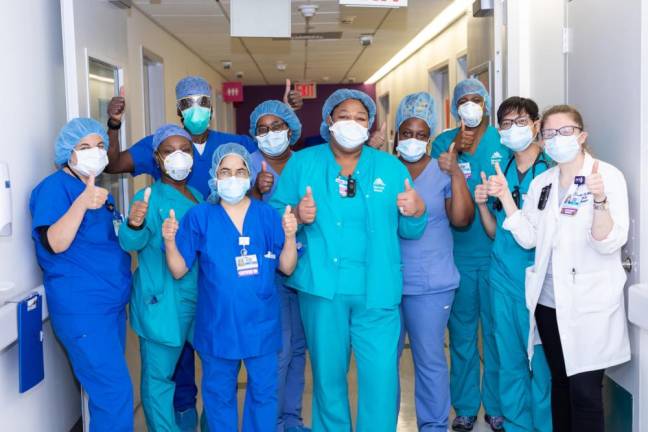Back in March, when the coronavirus outbreak started to touch New York, Ellis Rubinstein, who serves as the president of the New York Academy of Sciences, began to worry about the city’s ability to meet the moment.
“It was at the time when most of the conversation was about the need for masks and garments and all of the PPE,” said Rubinstein. “They hadn’t really focused yet on the disaster of not having enough people trained for ICU units and critical care.”
Around this time, Rubinstein’s daughter sent him an article about a company in Stockholm, Sweden, called Sana Labs. Since 2016, Sana Labs has been operating in the artificial intelligence sphere, creating personalized, adaptive learning programs for a variety of industries in the corporate sector. The program works by asking a user question to identify the gaps in one’s knowledge and adapts to center the curricula around those gaps. This adaptive aspect of the program shortens the time it takes to achieve a level of mastery in a given subject — condensing what was once months of schooling into a several hour course.
As the pandemic put the world on lockdown and overwhelmed its hospitals, Sana Labs struck a partnership with the Karolinska Institute — a premiere medical university in Sweden — and Scandinavian Airlines to create a program called Project Florence, after Florence Nightingale. The program uses Sana Labs’ technology to “upskill” furloughed flight attendants, who are trained to deal with health emergencies, so that they could assist health care workers in Swedish hospitals.
“I thought, maybe we should try in New York what they’re doing in Sweden,” said Rubinstein, who then reached out to Mount Sinai to find out if the hospital might be able to use this AI-learning program. The answer was yes.
To date, Mount Sinai has trained 726 non-critical care nurses to be able to care for coronavirus patients in a 16-hour course. The Project Florence course focused on staff safety and minimization of transmission, oxygenation and ventilation, airway management, oxygen supply systems acute respiratory distress syndrome, mechanical ventilation and the management of shock.
“The need to address, respond, and care for the surge of critically ill patients coming through our doors was imperative,” said Natalie Callis, the senior director of Nursing Professional Development Strategy and Implementation at the Mount Sinai Health System. “Project Florence’s ability to utilize AI-powered adaptive assessment to address individual skills gaps gave us the ability to upskill our clinical nurses in [an] efficient and efficacious manner.”
Globally, the impact of Project Florence has been immense, as the program has been deployed in over 70 countries to upskill more than 50,000 nurses.
“It’s been an inspiring past few months seeing how the technology can empower nurses that are sacrificing so much to save others,” said Joel Hellermark, the Chief Executive Officer at Sana Labs. “These are exactly the reasons we founded Sana for from the beginning.”
Hellermark said when a number of health systems, including the New York Academy of Sciences, reached out to Sana Labs, he decided to commit the company’s design, engineering and research team to support in any capacity that they could.
“What we have been quite particularly struck by is the impact that nurses are reporting where they are feeling that the system can very efficiently focus on the knowledge gaps and serve them the exact resources that they need,” said Hellermark.
Other Crises
As the demand on the city’s hospitals has lessened, Rubinstein and others at New York Academy of Sciences are thinking about how the adaptive learning technology could be applied to other crises.
One such application would be through NYAS’s alliance with UNICEF and the United Nations: to train community health care workers in African countries where they do not have enough professional medical personnel for their respective populations.
In a number of developing countries, and especially in Sub Saharan Africa, a majority of the population is between the ages of 10 and 20 years old, explained Paul Mikov, the senior vice president of global partnerships at NYAS. The problem that follows from this fact, Mikov said, is that no more than 25 percent of these young people will attend high school — let alone university. Therefore, the need for a high quality, low cost program that results in the development of skills and prepares young people for the workforce is abundant, said Mikov.
“But this issue of skilling and upskilling is not limited to the developing world,” said Mikov. “It’s really a universal issue and in the United States as well.”
In the United States, the need for AI-learning is growing, especially in the aftermath of the pandemic. A reported 40 million Americans have been laid off, and many of those jobs not are expected to return.
“Economies are being changed, forced to change,” said Mikov. “That will force many to consider being reskilled, maybe changing careers from one industry sector into another. I think there’s an enormous need in the area of reskilling and upskilling, as Project Florence has been upskilling nurses.”
The technology that helped stem the pandemic’s damage to public health could also be the program that helps repair the financial damage inflicted by the pandemic.
“It’s been an inspiring past few months seeing how the technology can empower nurses that are sacrificing so much to save others.” Joel Hellermark, CEO at Sana Labs

